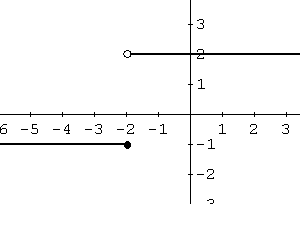Note: As x gets closer to c, the closer y gets to L
Example:
- One way to solve this is by putting 2 in for x.
- Another way is to make a table
|
|
The closer x gets to 2 (from both sides) the closer f(x) gets to 5
Describing the limit
Limits that Do Not Exist (DNR):
- when the left and right behaviors are different

the limit from the left would be -2, but the limit from the right would be 2.
The limit from the left side is described as =L)
The - sign above the 2 shows it is from the left side
The limit from the right side is 2 (c) with a + sign =L)
2. If a function increases without a bound, f(x) can be as large as you want
 The asymptote of x=0 causes you to be able to choose a number as close to 0 and it keeps decreasing
The asymptote of x=0 causes you to be able to choose a number as close to 0 and it keeps decreasing 3. When it Oscillates between two different numbers

the limit just switches between 1 and -1.
Continuity:
If a function is continuous at c then =\lim_{x\rightarrow c^{+}}f(x)=f(c))
- A trick for knowing if a graph is continuous is if you can draw it out without lifting up your pencil.
- Discontinuous graphs include: BREAKS, HOLES AND ASYMPTOTES
No comments:
Post a Comment